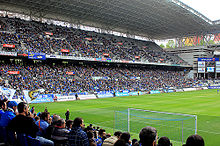Estadio Carlos Tartiere
 UEFA Category 3 stadium | |
 | |
| Full name | Estadio Municipal Carlos Tartiere |
|---|---|
| Location | Oviedo, Spain |
| Coordinates | 43°21′39″N 5°52′13″W / 43.360783°N 5.870222°W |
| Owner | Ayuntamiento de Oviedo |
| Operator | Real Oviedo |
| Capacity | 30,500[1] |
| Record attendance | 30,500 (Real Oviedo vs Sporting de Gijón, 28 October 2001) |
| Field size | 105 m × 68 m (344 ft × 223 ft) |
| Surface | Grass |
| Construction | |
| Opened | September 20, 2000 |
| Architect | Carlos Buxadé Ribot Joan Margarit Consarnau Emilio Llano |
| Tenants | |
| Real Oviedo (2000–present) Spain national football team (selected matches) | |



Estadio Municipal Carlos Tartiere, also known as Nuevo Carlos Tartiere (English: New Carlos Tartiere), is a multi-use stadium in Oviedo, Spain. It holds 30,500 spectators and replaced the former stadium of the same name, built in 1932.
History
The first match played in this stadium took place on September 17, 2000, a Primera División match between Real Oviedo and Las Palmas. The stadium was officially opened on September 20, 2000, with a friendly match between Real Oviedo and FK Partizan Beograd.
It is currently used mostly for football matches by Real Oviedo.
The new stadium has been severally criticized, especially its location, which does not have adequate accesses and emergency exits for large attendances. Also the pitch is hard to maintain, due to its moist environment and the lack of sunlight, especially during the winter. Despite these facts, Emilio Llano, one of the architects of the stadium, has defended the stadium and claimed that "the problem could be in the grass and not in the subsoil".[2]
The first sold-out match was on 28 October 2001, in the first Asturian derby in the new stadium. Sporting de Gijón won that game by 0–2.
On 24 May 2009, Real Oviedo beat the attendance record in a Tercera División game with 27,214 spectators. It was in the first leg of the 2009 Group Winners play-off against RCD Mallorca B, and the blues won by 1–0.[3]
International matches
The first international game was held on 23 December 2000, when the autonomous team Asturias played a friendly game against Macedonia. 25,000 people assisted to the game, which finished 1–0 with a goal of Juanele.
Spain played twice in the new Carlos Tartiere. The first one, on 6 June 2001, against Bosnia and Herzegovina in a game which finished 4–1 for The red one and the second, on 12 September 2007, against Latvia, finishing with a 2–0 win.
In 2011, the Spain national under-21 football team played an official game against Poland. Spain won 2–0.
On 5 September 2015 at UEFA Euro 2016 qualifying, Spain won against Slovakia with 2-0.
Spain matches at Carlos Tartiere
| Data | Opponent | Score | Competition | Att. |
|---|---|---|---|---|
| 2 June 2001 | 4–1 | 2002 FIFA World Cup qualification | 22,000 | |
| 12 September 2007 | 2–0 | UEFA Euro 2008 qualifying | 25,000 | |
| 5 September 2015 | 2–0 | UEFA Euro 2016 qualifying | 19,874 |
League attendances
This is a list of league and playoffs games attendances of Real Oviedo at the new Carlos Tartiere stadium.[4]
The new stadium was closured for one game after a game against Sporting de Gijón in the 2002–03 season. The game outside this stadium is not included in the stats. It was played at Estadio Román Suárez Puerta in Avilés against Levante.
| Season | Total | High | Low | Average |
|---|---|---|---|---|
| 2000–01 La Liga | 452,200 | 30,000 | 16,500 | 23,800 |
| 2001–02 Segunda División | 319,050 | 30,500 | 7,531 | 15,193 |
| 2002–03 Segunda División | 221,797 | 12,898 | 7,180 | 11,090 |
| 2003–04 Tercera División | 149,900 | 20,127 | 3,867 | 7,138 |
| 2004–05 Tercera División | 154,643 | 21,000 | 4,321 | 7,364 |
| 2005–06 Segunda División B | 120,188 | 8,622 | 3,879 | 6,326 |
| 2006–07 Segunda División B | 98,912 | 6,935 | 1,000 | 5,206 |
| 2007–08 Tercera División | 111,090 | 23,915 | 1,000 | 5,847 |
| 2008–09 Tercera División | 117,504 | 27,214 | 4,000 | 5,875 |
| 2009–10 Segunda División B | 174,330 | 20,136 | 5,983 | 8,717 |
| 2010–11 Segunda División B | 115,690 | 8,557 | 4,354 | 6,089 |
| 2011–12 Segunda División B | 126,481 | 10,121 | 5,095 | 6,657 |
| 2012–13 Segunda División B | 213,221 | 20,635 | 5,650 | 10,153 |
| 2013–14 Segunda División B | 145,521 | 15,132 | 4,506 | 8,085 |
| 2014–15 Segunda División B | 289,205 | 30,500 | 8,759 | 13,772 |
| 2015–16 Segunda División | 291,670 | 22,634 | 8,137 | 13,889 |
| 2016–17 Segunda División | 284,508 | 18,281 | 8,098 | 13,548 |
| 2017–18 Segunda División | 294,062 | 25,996 | 10,312 | 14,003 |
References
- ^ Stadiums of Real Oviedo Archived 2014-04-10 at the Wayback Machine; Real Oviedo website
- ^ Llano: "La ubicación es de manual."; La Nueva España, 31 January 2013
- ^ 27.214 carbayones estuvieron en el Tartiere; Marca, 25 May 2014 Template:Es
- ^ Asistencia histórica de espectadores al Carlos Tartiere Archived 2013-07-26 at archive.today; LNE.es
